MITSUBISHI L200 2004 Owner's Manual (in English)
Manufacturer: MITSUBISHI, Model Year: 2004, Model line: L200, Model: MITSUBISHI L200 2004Pages: 264, PDF Size: 4.14 MB
Page 101 of 264
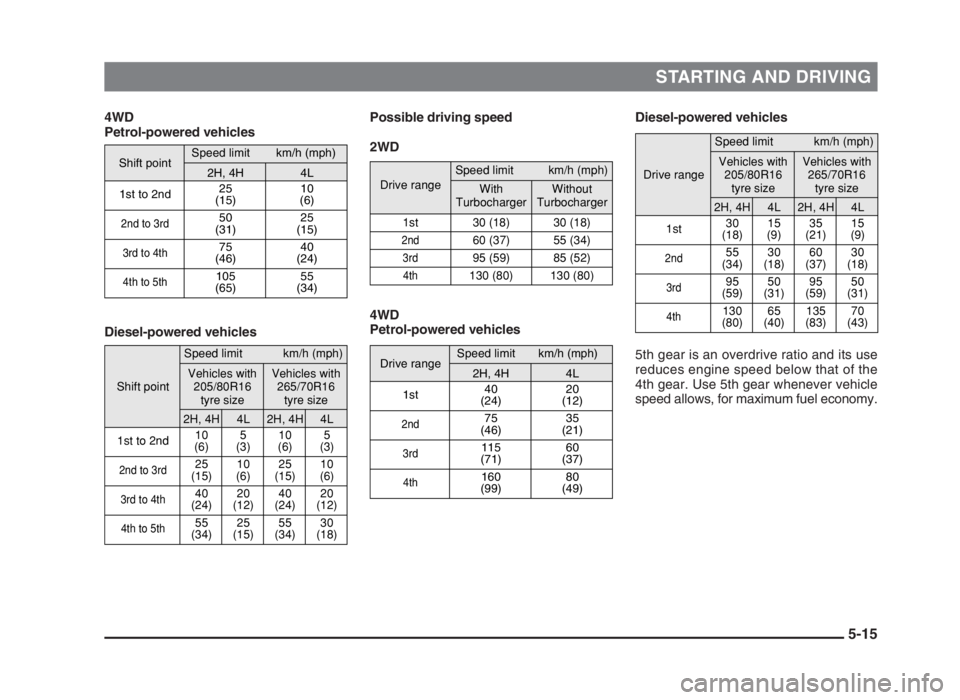
STARTING AND DRIVING
5-15
Diesel-powered vehicles
5th gear is an overdrive ratio and its use
reduces engine speed below that of the
4th gear. Use 5th gear whenever vehicle
speed allows, for maximum fuel economy. 4WD
Petrol-powered vehicles
Diesel-powered vehiclesPossible driving speed
2WD
4WD
Petrol-powered vehicles
Shift point
Speed limit km/h (mph)
2H, 4H4L
1st to 2nd25
(15)10
(6)
2nd to 3rd
50
(31)25
(15)
3rd to 4th
75
(46)40
(24)
4th to 5th
105
(65)55
(34)
Shift point
Speed limit km/h (mph)
Vehicles with
205/80R16
tyre sizeVehicles with
265/70R16
tyre size
2H, 4H4L2H, 4H4L
1st to 2nd10
(6)5
(3)10
(6)5
(3)
2nd to 3rd25
(15)10
(6)25
(15)10
(6)
3rd to 4th40
(24)20
(12)40
(24)20
(12)
4th to 5th55
(34)25
(15)55
(34)30
(18)
Drive range
Speed limit km/h (mph)
With
TurbochargerWithout
Turbocharger
1st 30 (18) 30 (18)
2nd
60 (37) 55 (34)
3rd
95 (59) 85 (52)
4th
130 (80) 130 (80)
Drive range
Speed limit km/h (mph)
2H, 4H4L
1st40
(24)20
(12)
2nd
75
(46)35
(21)
3rd
115
(71)60
(37)
4th
160
(99)80
(49)
Drive range
Speed limit km/h (mph)
Vehicles with
205/80R16
tyre sizeVehicles with
265/70R16
tyre size
2H, 4H4L2H, 4H4L
1st30
(18)15
(9)35
(21)15
(9)
2nd
55
(34)30
(18)60
(37)30
(18)
3rd
95
(59)50
(31)95
(59)50
(31)
4th
130
(80)65
(40)135
(83)70
(43)
05engL2_240082_4 22-01-2004 13:05 Page 5-15
Page 102 of 264

STARTING AND DRIVING
5-16
Automatic transmission
EI04ABA
The transmission has 4 forward gears and
1 reverse gear.
The individual gears are selected auto-
matically, depending on the position of the
gear selector lever, the speed of the vehi-
cle and the position of the accelerator
pedal.
The selector lever has 6 positions, and is
equipped with a lock button (A) to avoid in-
advertent selection of the wrong position.
Button must be pressed to move the
lever.
Button need not be pushed to move
the selector lever.
WARNING(1) If the button is always de-
pressed to operate the selector
lever, the lever may be acciden-
tally shifted into the “P”, “R”,
“2”, or “L” position.
Be sure not to depress the but-
ton when performing the opera-
tions indicated by in the illus-
tration.
(2) Always depress the brake pedal
when shifting the selector lever
into another gear from “P”
(PARK) or “N” (NEUTRAL) posi-
tion.
When beginning to drive, do not
shift the selector lever from “P”
(PARK) or “N” (NEUTRAL) posi-
tion while depressing the accel-
erator pedal, doing so is danger-
ous because the vehicle will
“jump” forward or backward.
Indicator lamps
The indicator lamps in the instrument
panel are for indicating the selector lever
position and one of them will illuminate
when the ignition is switched “ON”, de-
pending on the position of the shift lever.
I04A279
A
I04A071
05engL2_240082_4 22-01-2004 13:05 Page 5-16
Page 103 of 264
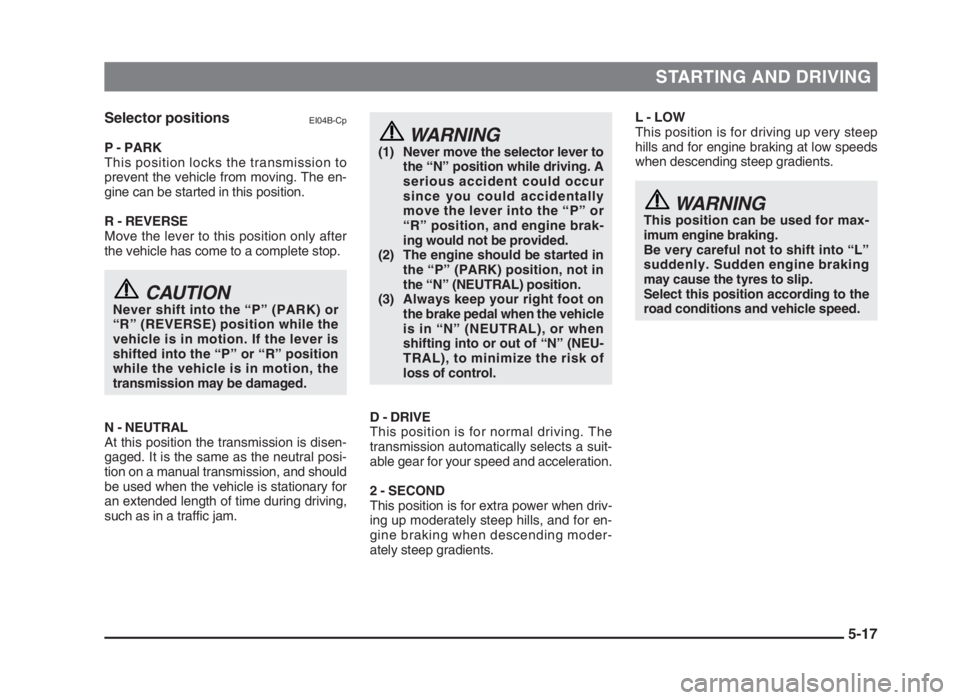
STARTING AND DRIVING
5-17 Selector positions
EI04B-Cp
P - PARK
This position locks the transmission to
prevent the vehicle from moving. The en-
gine can be started in this position.
R - REVERSE
Move the lever to this position only after
the vehicle has come to a complete stop.
CAUTIONNever shift into the “P” (PARK) or
“R” (REVERSE) position while the
vehicle is in motion. If the lever is
shifted into the “P” or “R” position
while the vehicle is in motion, the
transmission may be damaged.
N - NEUTRAL
At this position the transmission is disen-
gaged. It is the same as the neutral posi-
tion on a manual transmission, and should
be used when the vehicle is stationary for
an extended length of time during driving,
such as in a traffic jam.
L - LOW
This position is for driving up very steep
hills and for engine braking at low speeds
when descending steep gradients.
WARNINGThis position can be used for max-
imum engine braking.
Be very careful not to shift into “L”
suddenly. Sudden engine braking
may cause the tyres to slip.
Select this position according to the
road conditions and vehicle speed.
WARNING(1) Never move the selector lever to
the “N” position while driving. A
serious accident could occur
since you could accidentally
move the lever into the “P” or
“R” position, and engine brak-
ing would not be provided.
(2) The engine should be started in
the “P” (PARK) position, not in
the “N” (NEUTRAL) position.
(3) Always keep your right foot on
the brake pedal when the vehicle
is in “N” (NEUTRAL), or when
shifting into or out of “N” (NEU-
TRAL), to minimize the risk of
loss of control.
D - DRIVE
This position is for normal driving. The
transmission automatically selects a suit-
able gear for your speed and acceleration.
2 - SECOND
This position is for extra power when driv-
ing up moderately steep hills, and for en-
gine braking when descending moder-
ately steep gradients.
05engL2_240082_4 22-01-2004 13:05 Page 5-17
Page 104 of 264
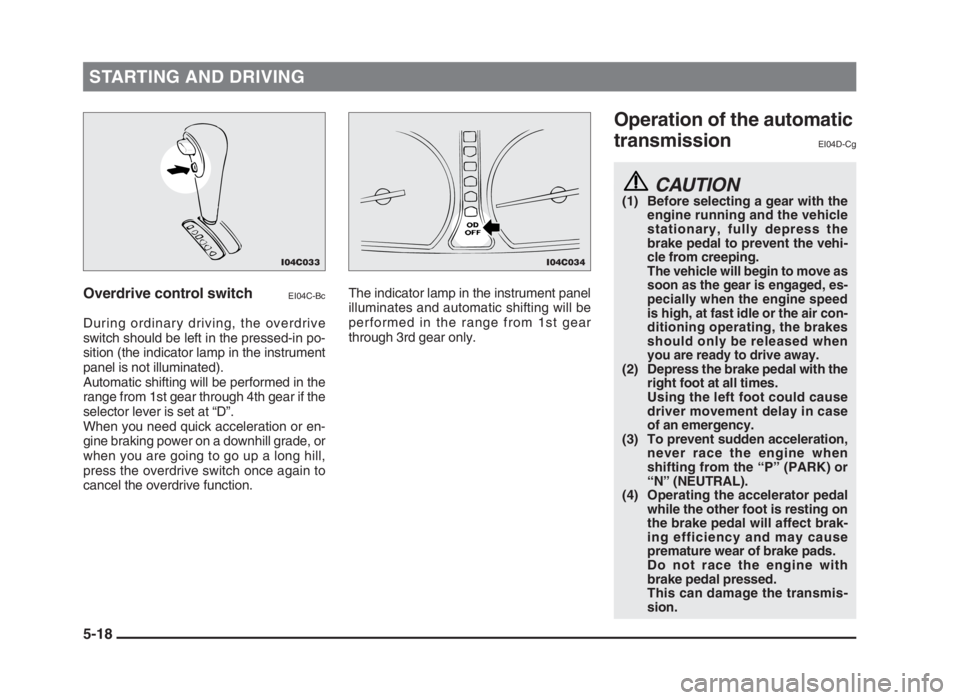
STARTING AND DRIVING
5-18
Operation of the automatic
transmission
EI04D-Cg
CAUTION(1) Before selecting a gear with the
engine running and the vehicle
stationary, fully depress the
brake pedal to prevent the vehi-
cle from creeping.
The vehicle will begin to move as
soon as the gear is engaged, es-
pecially when the engine speed
is high, at fast idle or the air con-
ditioning operating, the brakes
should only be released when
you are ready to drive away.
(2) Depress the brake pedal with the
right foot at all times.
Using the left foot could cause
driver movement delay in case
of an emergency.
(3) To prevent sudden acceleration,
never race the engine when
shifting from the “P” (PARK) or
“N” (NEUTRAL).
(4) Operating the accelerator pedal
while the other foot is resting on
the brake pedal will affect brak-
ing efficiency and may cause
premature wear of brake pads.
Do not race the engine with
brake pedal pressed.
This can damage the transmis-
sion.
Overdrive control switchEI04C-Bc
During ordinary driving, the overdrive
switch should be left in the pressed-in po-
sition (the indicator lamp in the instrument
panel is not illuminated).
Automatic shifting will be performed in the
range from 1st gear through 4th gear if the
selector lever is set at “D”.
When you need quick acceleration or en-
gine braking power on a downhill grade, or
when you are going to go up a long hill,
press the overdrive switch once again to
cancel the overdrive function.The indicator lamp in the instrument panel
illuminates and automatic shifting will be
performed in the range from 1st gear
through 3rd gear only.
I04C033I04C034
05engL2_240082_4 22-01-2004 13:05 Page 5-18
Page 105 of 264
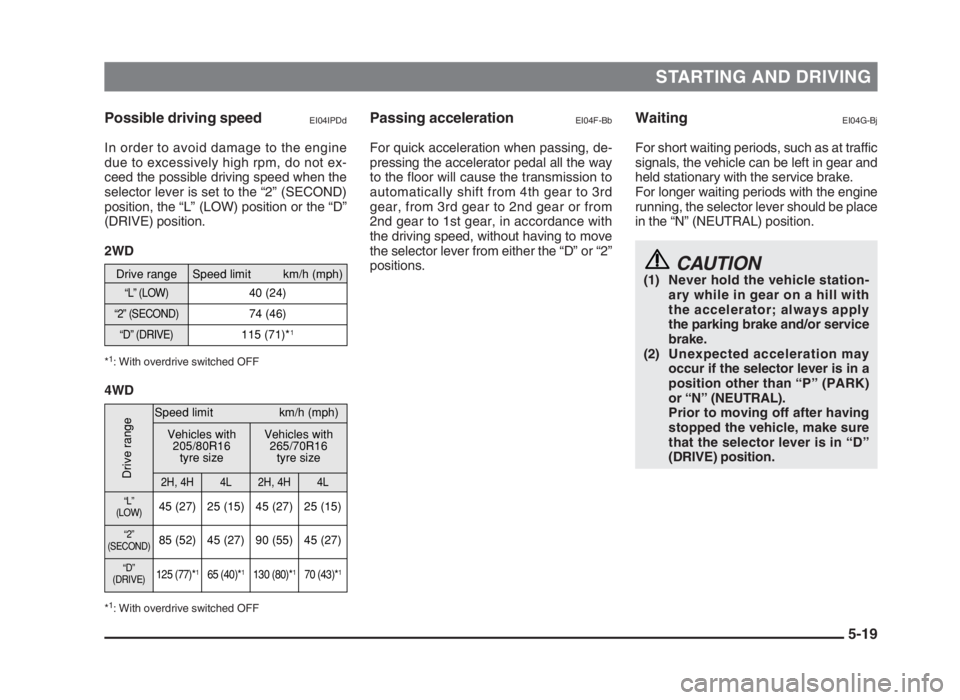
STARTING AND DRIVING
5-19 Passing acceleration
EI04F-Bb
For quick acceleration when passing, de-
pressing the accelerator pedal all the way
to the floor will cause the transmission to
automatically shift from 4th gear to 3rd
gear, from 3rd gear to 2nd gear or from
2nd gear to 1st gear, in accordance with
the driving speed, without having to move
the selector lever from either the “D” or “2”
positions.
Possible driving speedEI04IPDd
In order to avoid damage to the engine
due to excessively high rpm, do not ex-
ceed the possible driving speed when the
selector lever is set to the “2” (SECOND)
position, the “L” (LOW) position or the “D”
(DRIVE) position.
2WD
*1: With overdrive switched OFF
4WD
*1: With overdrive switched OFF
WaitingEI04G-Bj
For short waiting periods, such as at traffic
signals, the vehicle can be left in gear and
held stationary with the service brake.
For longer waiting periods with the engine
running, the selector lever should be place
in the “N” (NEUTRAL) position.
CAUTION(1) Never hold the vehicle station-
ary while in gear on a hill with
the accelerator; always apply
the parking brake and/or service
brake.
(2) Unexpected acceleration may
occur if the selector lever is in a
position other than “P” (PARK)
or “N” (NEUTRAL).
Prior to moving off after having
stopped the vehicle, make sure
that the selector lever is in “D”
(DRIVE) position.
Drive range
Speed limit km/h (mph)
“L” (LOW)
40 (24)
“2” (SECOND)
74 (46)
“D” (DRIVE)
115 (71)*
1
Drive range
Speed limit km/h (mph)
Vehicles with
205/80R16
tyre sizeVehicles with
265/70R16
tyre size
2H, 4H4L2H, 4H4L
“L”
(LOW)45 (27) 25 (15) 45 (27) 25 (15)
“2”
(SECOND)85 (52) 45 (27) 90 (55) 45 (27)
“D”
(DRIVE)125 (77)*165 (40)*1130 (80)*170 (43)*1
05engL2_240082_4 22-01-2004 13:05 Page 5-19
Page 106 of 264
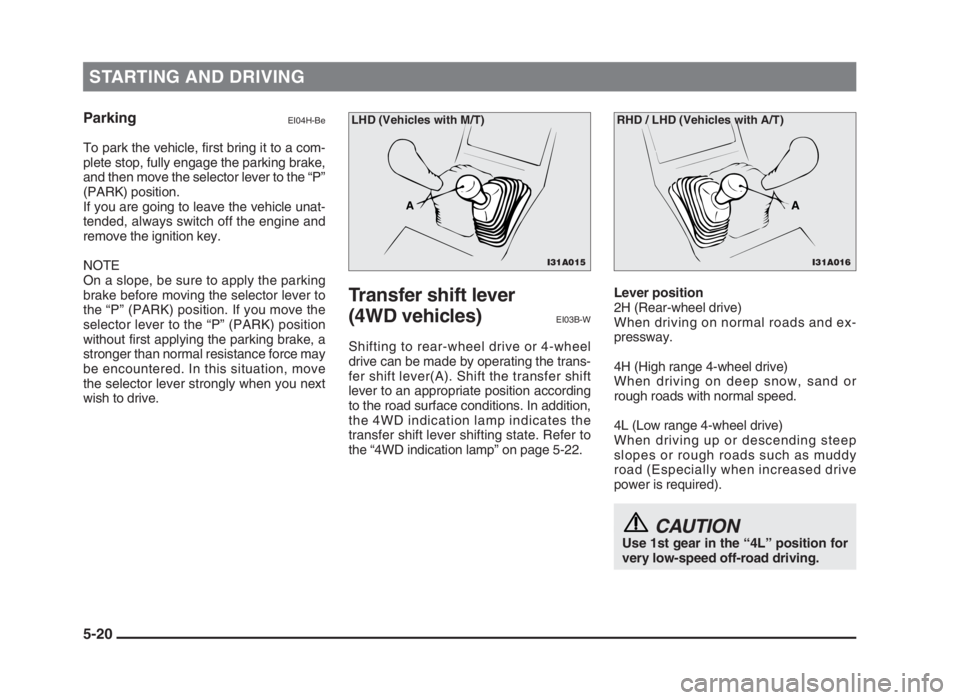
STARTING AND DRIVING
5-20 Parking
EI04H-Be
To park the vehicle, first bring it to a com-
plete stop, fully engage the parking brake,
and then move the selector lever to the “P”
(PARK) position.
If you are going to leave the vehicle unat-
tended, always switch off the engine and
remove the ignition key.
NOTE
On a slope, be sure to apply the parking
brake before moving the selector lever to
the “P” (PARK) position. If you move the
selector lever to the “P” (PARK) position
without first applying the parking brake, a
stronger than normal resistance force may
be encountered. In this situation, move
the selector lever strongly when you next
wish to drive.
Transfer shift lever
(4WD vehicles)
EI03B-W
Shifting to rear-wheel drive or 4-wheel
drive can be made by operating the trans-
fer shift lever(A). Shift the transfer shift
lever to an appropriate position according
to the road surface conditions. In addition,
the 4WD indication lamp indicates the
transfer shift lever shifting state. Refer to
the “4WD indication lamp” on page 5-22.Lever position
2H (Rear-wheel drive)
When driving on normal roads and ex-
pressway.
4H (High range 4-wheel drive)
When driving on deep snow, sand or
rough roads with normal speed.
4L (Low range 4-wheel drive)
When driving up or descending steep
slopes or rough roads such as muddy
road (Especially when increased drive
power is required).
CAUTIONUse 1st gear in the “4L” position for
very low-speed off-road driving.
I31A015
A
LHD (Vehicles with M/T)
I31A016
A
RHD / LHD (Vehicles with A/T)
05engL2_240082_4 22-01-2004 13:05 Page 5-20
Page 107 of 264
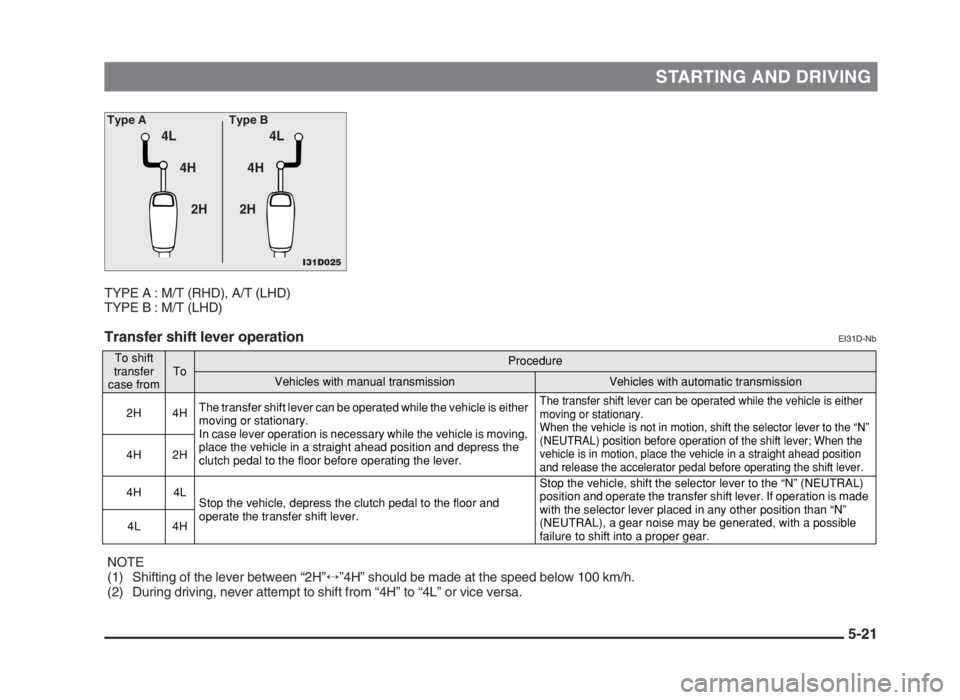
STARTING AND DRIVING
EI31D-Nb
5-21
TYPE A : M/T (RHD), A/T (LHD)
TYPE B : M/T (LHD)
Transfer shift lever operation
I31D025
4L 4L
4H 4H
2H 2H
Type A Type B
To shift
transfer
case fromToProcedure
Vehicles with manual transmissionVehicles with automatic transmission
2H 4HThe transfer shift lever can be operated while the vehicle is either
moving or stationary.
In case lever operation is necessary while the vehicle is moving,
place the vehicle in a straight ahead position and depress the
clutch pedal to the floor before operating the lever.
The transfer shift lever can be operated while the vehicle is either
moving or stationary.
When the vehicle is not in motion, shift the selector lever to the “N”
(NEUTRAL) position before operation of the shift lever; When the
vehicle is in motion, place the vehicle in a straight ahead position
and release the accelerator pedal before operating the shift lever.
4H 2H
4H 4L
Stop the vehicle, depress the clutch pedal to the floor and
operate the transfer shift lever.Stop the vehicle, shift the selector lever to the “N” (NEUTRAL)
position and operate the transfer shift lever. If operation is made
with the selector lever placed in any other position than “N”
(NEUTRAL), a gear noise may be generated, with a possible
failure to shift into a proper gear. 4L 4H
NOTE
(1) Shifting of the lever between “2H”↔”4H” should be made at the speed below 100 km/h.
(2) During driving, never attempt to shift from “4H” to “4L” or vice versa.
05engL2_240082_4 22-01-2004 13:05 Page 5-21
Page 108 of 264
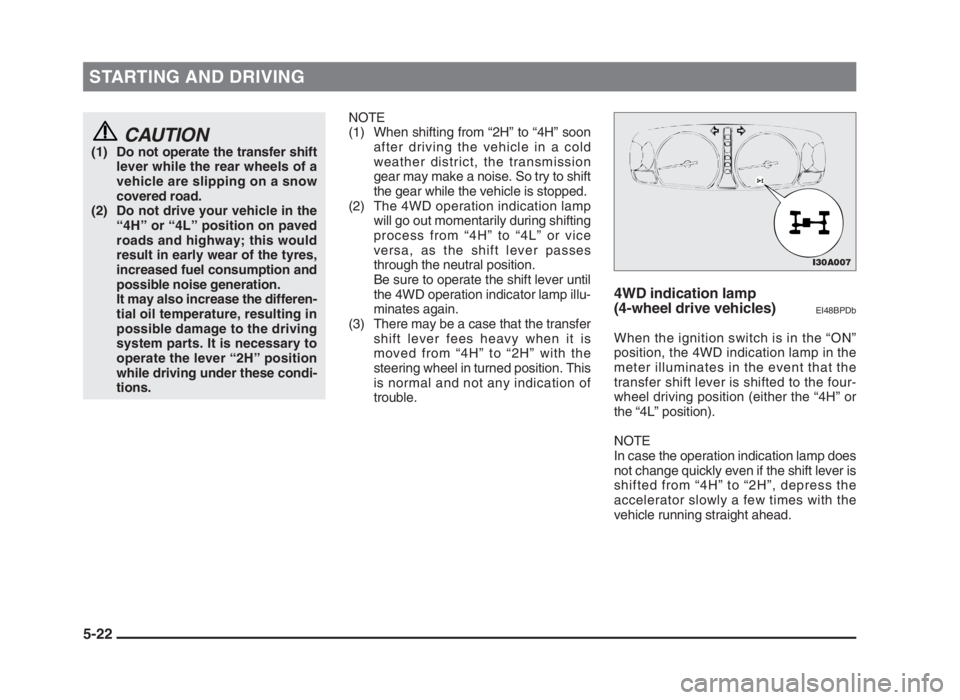
STARTING AND DRIVING
NOTE
(1) When shifting from “2H” to “4H” soon
after driving the vehicle in a cold
weather district, the transmission
gear may make a noise. So try to shift
the gear while the vehicle is stopped.
(2) The 4WD operation indication lamp
will go out momentarily during shifting
process from “4H” to “4L” or vice
versa, as the shift lever passes
through the neutral position.
Be sure to operate the shift lever until
the 4WD operation indicator lamp illu-
minates again.
(3) There may be a case that the transfer
shift lever fees heavy when it is
moved from “4H” to “2H” with the
steering wheel in turned position. This
is normal and not any indication of
trouble.
4WD indication lamp
(4-wheel drive vehicles)
EI48BPDb
When the ignition switch is in the “ON”
position, the 4WD indication lamp in the
meter illuminates in the event that the
transfer shift lever is shifted to the four-
wheel driving position (either the “4H” or
the “4L” position).
NOTE
In case the operation indication lamp does
not change quickly even if the shift lever is
shifted from “4H” to “2H”, depress the
accelerator slowly a few times with the
vehicle running straight ahead.
5-22
I30A007
CAUTION(1) Do not operate the transfer shift
lever while the rear wheels of a
vehicle are slipping on a snow
covered road.
(2) Do not drive your vehicle in the
“4H” or “4L” position on paved
roads and highway; this would
result in early wear of the tyres,
increased fuel consumption and
possible noise generation.
It may also increase the differen-
tial oil temperature, resulting in
possible damage to the driving
system parts. It is necessary to
operate the lever “2H” position
while driving under these condi-
tions.
05engL2_240082_4 22-01-2004 13:05 Page 5-22
Page 109 of 264
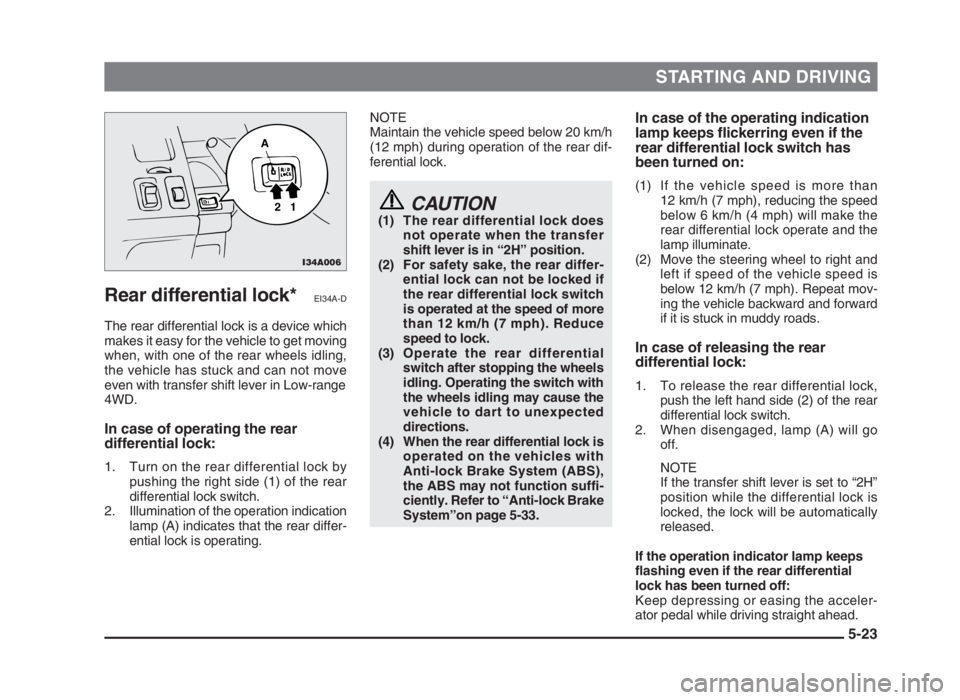
STARTING AND DRIVING
5-23
Rear differential lock*EI34A-D
The rear differential lock is a device which
makes it easy for the vehicle to get moving
when, with one of the rear wheels idling,
the vehicle has stuck and can not move
even with transfer shift lever in Low-range
4WD.
In case of operating the rear
differential lock:
1. Turn on the rear differential lock by
pushing the right side (1) of the rear
differential lock switch.
2. Illumination of the operation indication
lamp (A) indicates that the rear differ-
ential lock is operating.
In case of the operating indication
lamp keeps flickerring even if the
rear differential lock switch has
been turned on:
(1) If the vehicle speed is more than
12 km/h (7 mph), reducing the speed
below 6 km/h (4 mph) will make the
rear differential lock operate and the
lamp illuminate.
(2) Move the steering wheel to right and
left if speed of the vehicle speed is
below 12 km/h (7 mph). Repeat mov-
ing the vehicle backward and forward
if it is stuck in muddy roads.
In case of releasing the rear
differential lock:
1. To release the rear differential lock,
push the left hand side (2) of the rear
differential lock switch.
2. When disengaged, lamp (A) will go
off.
NOTE
If the transfer shift lever is set to “2H”
position while the differential lock is
locked, the lock will be automatically
released.
If the operation indicator lamp keeps
flashing even if the rear differential
lock has been turned off:
Keep depressing or easing the acceler-
ator pedal while driving straight ahead. NOTE
Maintain the vehicle speed below 20 km/h
(12 mph) during operation of the rear dif-
ferential lock.
CAUTION(1) The rear differential lock does
not operate when the transfer
shift lever is in “2H” position.
(2) For safety sake, the rear differ-
ential lock can not be locked if
the rear differential lock switch
is operated at the speed of more
than 12 km/h (7 mph). Reduce
speed to lock.
(3) Operate the rear differential
switch after stopping the wheels
idling. Operating the switch with
the wheels idling may cause the
vehicle to dart to unexpected
directions.
(4) When the rear differential lock is
operated on the vehicles with
Anti-lock Brake System (ABS),
the ABS may not function suffi-
ciently. Refer to “Anti-lock Brake
System”on page 5-33.
I34A006
2 1 A
05engL2_240082_4 22-01-2004 13:05 Page 5-23
Page 110 of 264
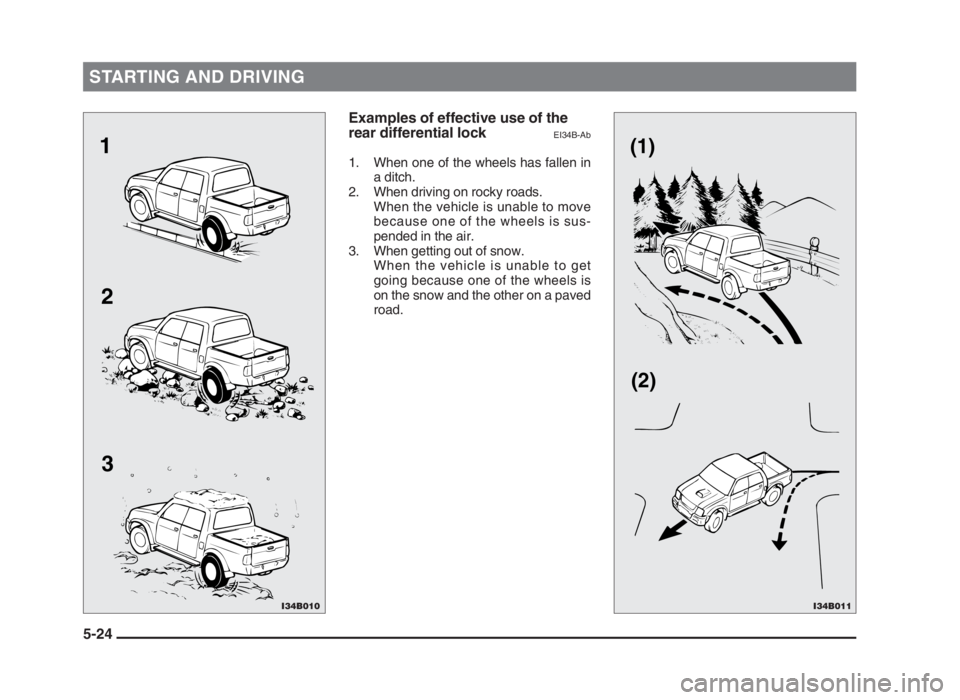
STARTING AND DRIVING
5-24Examples of effective use of the
rear differential lock
EI34B-Ab
1. When one of the wheels has fallen in
a ditch.
2. When driving on rocky roads.
When the vehicle is unable to move
because one of the wheels is sus-
pended in the air.
3. When getting out of snow.
When the vehicle is unable to get
going because one of the wheels is
on the snow and the other on a paved
road.
I34B010
1
2
3
I34B011
(1)
(2)
05engL2_240082_4 22-01-2004 13:05 Page 5-24